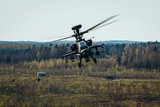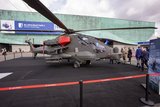Canadian Sea King deters pirates
On 18 April 2009 at about 3:00 p.m. local time, the MV Front Ardenne and the British fast fleet tanker RFA Wave Knight were transiting the main shipping channel between Somalia and Yemen when seven pirates in a blue skiff raced up to the merchant vessel.
Pirates in this area usually seek opportunities in waters free of naval patrols, so the men in the blue skiff probably mistook Wave Knight for another merchant vessel. In fact, she is an armed Royal Fleet Auxiliary crewed by trained naval personnel, who immediately fired warning shots at the pirates attacking Front Ardenne.
Radio communications from Wave Knight elicited a quick response from the Standing NATO Maritime Group 1 (SNMG1) task force that eventually developed into a co‑ordinated effort by five ships and two helicopters. The SNMG1 watch team in the flagship NRP Corte Real orchestrated the operation, maintaining continual visual and radar tracking for seven hours as the pirate skiff fled south toward the Somali coast and the promise of safety.
Meanwhile, HMCS Winnipeg was escorting the World Food Program freighter Abdul Raman to Bosasso, Somalia. Closely paralleling the coastline, Winnipeg's route put the frigate right between the pirate skiff and its destination.
As Winnipeg's air detachment scrambled to launch the ship's CH-124 Sea King helicopter, Palomino16, arrangements were made to stop the skiff for an eventual boarding. Palomino16 rapidly covered the 60 miles between the Canadian frigate and the skiff, and immediately began tracking it.
"From the moment we began to react to the unscheduled order to flying stations, we could sense that something interesting was about to happen," said Master Corporal David Tillotson, Palomino16's sensor operator. "We quickly got airborne and bustered [flew at top speed] to the scene. The fleeing speedboat being chased by a 30,000-ton auxiliary vessel was an impressive sight."
Orders were passed to the helicopter's crew commander to stop the pirates.
"You could feel the adrenaline flowing inside the aircraft, but everyone followed their training and moved smartly. We could see the pirates and their equipment clearly. We knew they were armed and, as they refused to stop despite our warnings, it became clear that they were also desperate or reckless - or both. We continued collecting imagery and I readied myself at my position behind the C6 machine-gun," said MCpl Tillotson.
As repeated warnings by radio were producing no result, the helicopter crew was ordered to fire warning shots ahead of the skiff.
"I felt as though I was in a heightened state of alertness and focussed on the task at hand and the careful application of fire. I saw the rounds from our gun rip through the water ahead of the skiff. After the fourth set of warning shots, it became clear that these guys were desperate to reach the Somali coast and had decided to just put their heads down and run," said MCpl Tillotson.
Palomino16 was eventually relieved of tracking duty by Smart Guy, a helicopter from the guided missile frigate USS Halyburton. The sun set, and the pirates continued on in darkness toward the Somali coast, and the waiting Winnipeg.
From his position in Winnipeg's Operations Room, Lieutenant (Navy) Christopher Nucci played a central role in organizing the action. "From a tactical perspective, there were a lot of balls in the air. As we tracked the skiff and Wave Knight on their southbound course, co‑ordinating instructions were coming across the radio to pass our escort duties to the USS Halyburton. The air picture was very fluid as we co‑ordinated refuelling the two helicopters, who alternated between supporting the chase and covering the Abdul Raman," he said.
Winnipeg was on course to intercept the action and, as she approached visual range, her commanding officer, Commander Craig Baines, ordered all the lights extinguished. As Winnipeg prepared to pounce, Wave Knight and Smart Guy drove the skiff towards her.
Eyes on the bridge boring into the blackness were soon rewarded by the appearance on the horizon of two white pinpricks - the masthead steaming lights on Wave Knight - and, above them, Smart Guy's blinking red warning lights. As the lights grew stronger, staying fine on the starboard bow, the bridge was so quiet everyone could hear the planned manoeuvre. "Green to green at 1,000 yards. Once we pass, we will both turn hard to starboard," said Cdr Baines, directing the naval communicators to pass the signal to the quickly closing Wave Knight.
"You could hear a pin drop as the ships approached at a relative closing speed of over 40 knots. The plan was to get in close unnoticed, a difficult trick for a 450-foot frigate. We kept ranging down on our displays as the distance between us diminished and, as we passed our closest point of approach, everyone held onto their chairs as the ship heeled hard to port during the starboard turn. I hurried to the bridge in anticipation of close action," said combat officer Lt(N) Al Compton.
Achieving complete surprise, Winnipeg was within several hundred yards of the skiff when her high-powered Xenon search-light captured the pirates in its solid white beam.
"When I got to the bridge, I expected pandemonium but was surprised by the calm. There must have been 20 people there but all was strangely quiet. The CO issued a stream of commands to manoeuvre the ship and keep the skiff on the port beam," said Lt(N) Compton. "The entire scenario was surreal. The search-light operator struggled to keep the altering skiff illuminated as pre-recorded Somali commands were transmitted to the pirates over a loudspeaker. The occasional para-flare lit the area like day for brief periods before being swallowed back into darkness. But the feature of the engagement was definitely the .50-calibre warning shots."
Orders were passed, and five sets of warning shots were eventually delivered before the pirates complied. All the while, they were jettisoning their weapons and the ladder they used in their attack on Front Ardenne.
"With the bridge doors open, our ears rang each time the heavy machine-guns thundered away. Each burst sent streams of light into the night and we all watched fixated as tracers pierced the black water astern of the skiff," recalled Lt(N) Compton.
Some of the skiff's occupants made gestures of surrender, but a few minutes passed before the driver stopped the boat. The pirates lifted their arms and the boarding party was ordered over the side.
As the boarding party's rescue diver, Leading Seaman Joseph Csiki was responsible for covering the approach with his C8 rifle. "There was an added sense of intensity among the boarding team as we approached the skiff, due partly to the night-time setting, but mostly because we knew what these guys had gone through before finally relenting," he said. "The smell of gas was very strong and I was shocked and concerned that some of the pirates were preparing to light cigarettes while ankle-deep in gas."
The two boats came together. The boarding team took control of the skiff and its occupants, and began their search.
"We knew what they were but, like most criminals, their first act was to profess innocence. They were quite adamant in their denials but their expressions changed when we showed them the aerial photos we had of them with their hooked ladder and assault rifles, all of which they had discarded during the chase. When one of our guys discovered an overlooked rifle grenade you could see the resignation in their eyes. They sat impassively from that point on," said LS Csiki.
As well as the rifle grenade, the search yielded knives, a GPS device, some cellular telephones, and a small quantity of drugs. Once it was determined that the pirates had been disarmed and no longer possessed the means to threaten shipping, they were released.
"It was very gratifying to board, search and seize materiel from a vessel that we knew categorically had been involved in piracy. We train and prepare for the worst-case scenario, but our job is certainly made easier by their habit of tossing their weapons in the ocean whenever we get close," LS Csiki pointed out.
It is said that a warship is no ordinary office. By the same token, a Canadian sailor has no ordinary job - on this day, especially.
By Sub-Lieutenant Michael McWhinnie - Canadian Armed Forces
More from Defence Helicopter
-
![Germany to send WS-61 Westland Sea King helicopters to Ukraine]()
Germany to send WS-61 Westland Sea King helicopters to Ukraine
Germany has committed to sending Ukraine six of its 21 retiring WS-61 Westland Sea King multirole, amphibious helicopters.
-
![Boeing secures $271 million to advance modernisation of US Special Operations' MH-47G Chinook]()
Boeing secures $271 million to advance modernisation of US Special Operations' MH-47G Chinook
Boeing has clinched a major contract modification to further its backing of the US Special Operations Command’s MH-47G Chinook aircraft modernisation effort.
-
![Dubai Airshow 2023: South Korean homegrown helicopters make international debut]()
Dubai Airshow 2023: South Korean homegrown helicopters make international debut
Two KAI helicopters, the KUH-1E utility helicopter and the Light Attack Helicopter (LAH), have taken centre stage at the Dubai Airshow 2023.
-
![Italian Navy receives final NH90 helicopter]()
Italian Navy receives final NH90 helicopter
The Italian Navy now boasts a fleet of 56 NH90 helicopters comprising 46 SH-90As and 10 MH-90As.
-
![Argentina seeks AW109 and CH-46 Sea Knight helicopters]()
Argentina seeks AW109 and CH-46 Sea Knight helicopters
The Argentinian Air Force (FAA) and the Argentinian Naval Aviation Command (COAN) are looking for options to upgrade their helicopter fleets.
-
![DSEI 2023: Lockheed to produce about 40% of Black Hawks on UK soil if it wins NMH contest]()
DSEI 2023: Lockheed to produce about 40% of Black Hawks on UK soil if it wins NMH contest
Lockheed Martin promises a boost to the British job market and export opportunities, while strengthening ties with Poland and positioning the UK for a future in rotorcraft technology in the event of a New Medium Helicopter competition triumph.

























